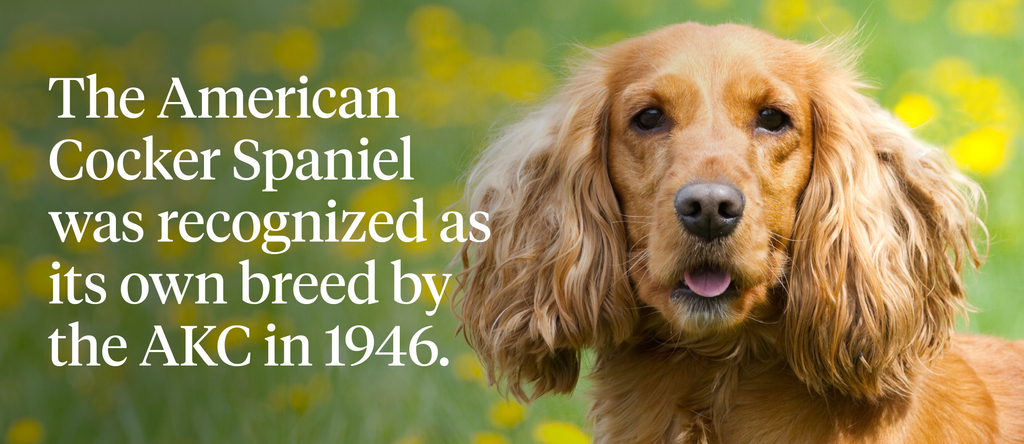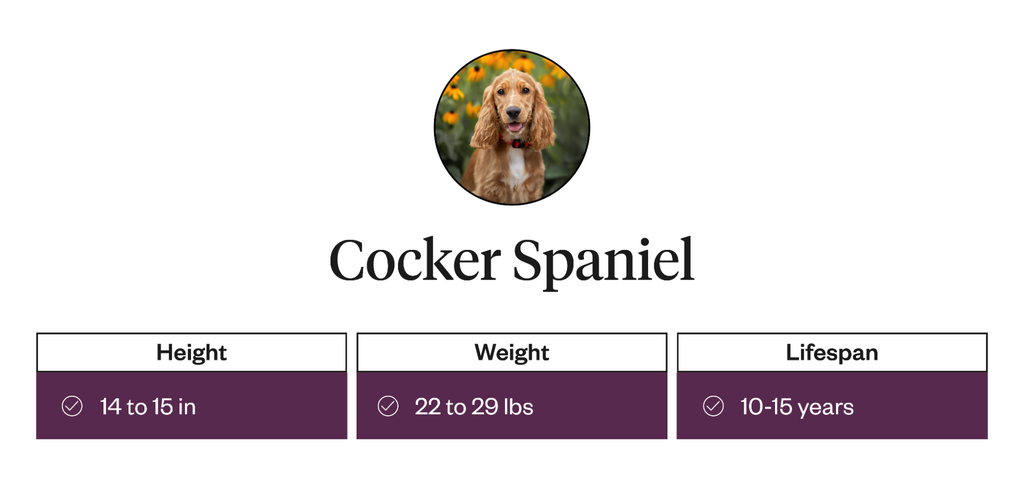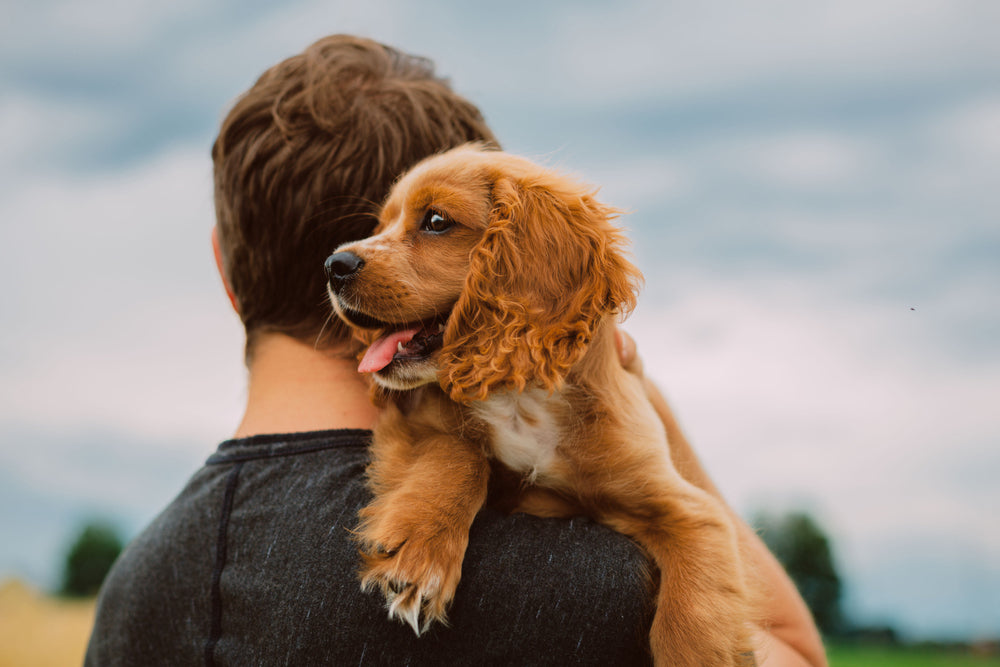11 Min Read
Cocker Spaniel: Pet Profile
Key takeaway
With origins in Spain and England, the Cocker Spaniel is a medium-sized dog beloved for their loyalty and stunning curly coat. Often friendly and playful, the Cocker Spaniel can make a great companion for many pet parents looking for a furry friend.

Why pet owners are switching to online vet care with Dutch
-
Prescriptions delivered free to you
-
Fast access to Licensed Vets over video
-
Unlimited video visits and follow-ups
The Cocker Spaniel was originally developed as a hunting dog with origins in Spain. The modern Cocker Spaniel emerged around 1850, although the Spaniel breed dates back to the 14th century. Over time, the breed has evolved into a beloved family pet and a wonderful companion.
Cocker Spaniels are considered medium sized dogs, and are prized for their loyalty and affectionate nature. The Cocker Spaniel is often an intelligent breed that makes them a little stubborn, but tends to be easy to train. They're prized for their beautiful coat colors and variations, their big, melty eyes, and genuine companionship.
The breed is known for its athleticism, gentleness, and responsiveness. Cocker Spaniels have retained their hunting instincts throughout centuries of breeding, which means they can be trained to be hunting companions, taught to play games such as hide and seek or scent tracking. They also make great playmates, often get along easily with other dogs, and are often good with children.
Read on to learn more about this popular breed and why they’ve become such a popular family pet.
- History & Origin of Cocker Spaniels
- Physical Attributes of Cocker Spaniels
- Behavioral Characteristics of Cocker Spaniels
- Cocker Spaniel Health Risks
- Caring For a Cocker Spaniel
- FAQs
- Final Notes
History & Origin of Cocker Spaniels
The modern Cocker Spaniel originated in the U.K. around 1850 and is the result of crossbreeding toy-sized spaniels with larger types. The breed standard as it's currently known was first recorded with the Kennel Club (England) in 1873. This marked the first time that the English Cocker Spaniel was recognized as a type of Spaniel and secured the breed standards going forward.1
A Spaniel's main job is that of a flushing dog. They're used for flushing game – making noise to encourage game to leave cover – from the underbrush for hunters. They primarily flushed birds and rabbits into the open and prevented the game from returning to their hiding spots. One of the types of birds that cockers flushed is the woodcock. Their proficiency at their job of scaring game birds led to them being called a Cocking Spaniel, later changed to Cocker Spaniel.1
The modern version of the breed emerged around 1850, but the physiology and physical appearance took time to settle. The crossbreeding often resulted in offspring that had varying characteristics, sizes, and coat colors in the same litter. It wasn't until 1879 when Obo, an English champion sire, was found to have offspring that had a consistent appearance and helped solidify the breed standard for the English version of the breed. His son, champion Obo II, is responsible for the American version of the breed.1
In 1902, the Cocker Spaniel Club was founded in England, firmly establishing the standard for the English Cocker Spaniel, and was followed by the English Cocker Spaniel Club of America in 1935 to preserve and promote English bloodlines. The American Cocker Spaniel was recognized as a separate breed and type by the AKC in 1946.1,2

Physical Attributes of Cocker Spaniels
The American Cocker Spaniel is a small-to-medium sized dog. It averages 14 to 15 inches (36 to 38 cm) in height at the shoulder, and weighs anywhere between 22 to 29 pounds (10 to 13 kg).
The English Cocker Spaniel is similar in height and weight, but averages 15 to 17 inches (38 to 43 cm) in height and 26 to 34 pounds (12 to 15 kg) in weight. Both breed types feature long, silky hair coats and come in a wide range of coat colors. Individuals can feature a broken coat, solid with ticking, black, black and tan, reddish-brown, liver color, and more. Just about every coat color is found in the Cocker Spaniel breed.
The American Cocker Spaniel is typically more compact than the English type, and has shorter legs. The English Cocker Spaniel features a longer muzzle and droopy lower lid, while the American Cocker Spaniel has a short muzzle that's more toy dog-like in appearance. Both types have a box-shaped skull with long floppy ears, short necks, and stout bodies. The average lifespan for both types is anywhere between 10 to 15 years.3

Behavioral Characteristics of Cocker Spaniels
Cocker Spaniels are often known for their outgoing personalities and tendency to love anyone who gives them attention. Their tails seem to be always wagging in delight as they explore the world around them and visit with other humans and animals.
The Cocker Spaniel breed tends to be affectionate with family members and other pets and generally loves to play when they’re played with. However, they’re not known to be highly active, which can be ideal for those who live in an apartment or residence with little or no yard space available. Of course, your Cocker Spaniel will need regular exercise to keep them happy and healthy, so daily walks are often enough to do so.
Additionally, Cocker Spaniels often have a medium energy level and like all dogs, need some mental stimulation from time to time. You can do this by implementing DIY enrichment activities or setting out food puzzles, sniff mats, or other toys that simulate a “job.” Keep in mind that you should only give these toys under supervision.
Cocker Spaniels are often very trainable and eager to please, making them a great choice for many households looking for a canine companion.4

Cocker Spaniel Health Risks
Cocker Spaniels have their share of health risks due to the fact they are a purebred, while other health issues are related to their conformation.3
Hip dysplasia
Hip dysplasia happens when the bones of the hip joint don't come together in the proper fashion. This can happen during a Cocker Spaniel's growth phase from puppy to adult. The issue is genetic in nature, which means individuals can carry the gene for hip dysplasia.
Intervertebral disc disease (IVDD)
IVDD is a condition of the spine that causes paralysis in the hind legs, and Cocker Spaniels are prone to suffering from the issue. It's caused by a ruptured disc that results in temporary or permanent hind leg paralysis. The rupture typically happens with no advance warning signs.
Arthritis
The breed is considered high-risk for arthritis due to the aforementioned joint problems. Keeping your Cocker Spaniel active helps prevent or slow down the appearance of arthritis.
Allergies
Cocker Spaniels have an average risk factor for allergies. That is, they don't have a genetic predisposition for hypersensitivity to allergens, but they are capable of suffering from hayfever and other irritants. Fortunately, it's easy to treat allergies when they arise with help from a veterinarian.
Ear problems
The breed's long and floppy ears predispose them to bacterial and fungal infections. Water is easily trapped in the ear canal and creates a breeding ground for bacteria. The same goes for fungal spores, especially if your dog has been swimming in stagnant water. Both issues are treatable, but drying out the ears after they get wet also helps to reduce the risk of infection.
Eye problems
Cocker Spaniels are genetically predisposed to eye conditions that include:
- Dry eye
- Glaucoma
- Conjunctivitis
- Progressive retinal atrophy
- Cherry eye
- Entropion
- Ectropion
- Distichiasis
Surgery is often the only solution for many of these issues, but individuals can have a good quality of life after the issue has been resolved.
Autoimmune disorders
An autoimmune disorder known as primary immune-mediated haemolytic anemia (IMHA) affects both types of Cocker Spaniels. The dog's immune system produces antibodies that attack its red blood cells and results in an anemic condition that can be mild or severe. Veterinary treatment for the condition is available, and a dog who exhibits the signs of IMHA needs to be treated as soon as possible.
Caring For a Cocker Spaniel
Cocker Spaniels are often easy to care for when you have quality pet care at your disposal. They're like any other dog in that they need regular exercise and stimulation to keep them mentally and physically fit. They should be kept on an appropriate diet to keep their weight in check and minimize the stress on their joints. A diet that consists of high-quality ingredients also helps keep the hair coat shiny and easy to brush.
The long ears of the breed present a challenge when it comes to feeding as the bottoms of the ears will drop into their food. This results in dirty ears that need extra maintenance. Using a tall dish that's designed for long-eared dogs can help prevent the issue.3,4
FAQs
Are Cocker Spaniels high-maintenance?
Cocker Spaniels are a little high maintenance due to their intelligence, drive, and grooming requirements. However, they're easily managed because they're happy to be a couch potato as well as playing games with their owners. Games that challenge their minds are recommended to keep them satisfied.
Regular trips to the groomers are a requirement due to their long, silky hair that mats and tangles if allowed to grow unchecked. Brushing everyday or every other day is recommended, but a groomer can trim the coat short to reduce the need for brushing.
Are male or female Cocker Spaniels more affectionate?
Both sexes are known for being affectionate, but this will vary depending on the individual.
Are Cocker Spaniels good dogs?
Yes, Cocker Spaniels can make great pets in a variety of contexts. They often do well as apartment dogs due to their smaller size and moderate exercise requirements. They have some maintenance needs to prevent health issues and require regular grooming, but these needs are easily met.

Final Notes
The Cocker Spaniel is one of the most popular breeds in the U.S., and not just for its good looks and trainability. They’re often personable dogs, loving, with plenty of energy, making them fun family pets.
Try Dutch telemedicine for pets and get convenient veterinary care for your dog's health issues. Your dog gets the preventive and ongoing care they need without a trip to the vet, and you can get insight from the vet on what to expect going forward.
Share
References
-
"Cocker Spaniel." Encyclopedia Britannica, Encyclopedia Britannica, Inc., 3 May 2023, https://www.britannica.com/animal/cocker-spaniel.
-
"Cocker Spaniel Breed Information. PDSA, The People's Dispensary for Sick Animals, https://www.pdsa.org.uk/pet-help-and-advice/looking-after-your-pet/puppies-dogs/medium-dogs/cocker-spaniel.
-
"Breed History." The English Cocker Spaniel Club of America, ECSCA, 2020, https://englishcocker.org/history/.
-
Paddock, Arliss. "English Cocker Spaniel History: Standing As a Breed of Its Own." American Kennel Club, 19 Aug, 2022, https://www.akc.org/expert-advice/dog-breeds/english-cocker-spaniel-history/.
-
"Common Cocker Spaniel Health Issues." Handicapped Pets.com, 23 April, 2021, https://www.handicappedpets.com/blog/cocker-spaniel-health/.



